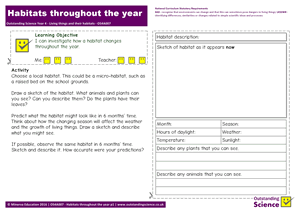

I can group organisms in different ways.
In this 2-player game, children cut out 24 images of animals and 12 challenge cards. They take turns challenging each other to group the images according to the challenge cards. Groups include tetrapods, herbivores, and mammals. When they have finished, children choose their favourite grouping method and use it to complete a 1-set Venn diagram.
I can group animals according to whether they are fish, amphibians, reptiles, birds or mammals.
Children learn about 5 different groups of animals - fish, amphibians, reptiles, bird, and mammals - and how we can identify them from their body features, behaviour, and life cycles. Children cut out 20 different images of these animals and place them in the correct group. They explain what the animals in each group have in common.

5 pages
I can identify whether an animal is a vertebrate or an invertebrate.
Children learn that animals can be classified as vertebrates (having a spine) or invertebrates (lacking a spine). They cut out 15 different pictures of animals and place them in the correct group.

2 pages
I can use a classification key to identify familiar organisms.
Children learn that a dichotomous key (a branching classification key in which each question has exactly two answers) can be used to identify organisms. Children use the key provided to identify 12 different animals. They use a word bank to help them name the animals.

2 pages
I can use a classification key to identify invertebrates.
Children use a dichotomous classification key to identify 9 different types of invertebrate (centipede, slug, worm, snail, ant, beetle, woodlouse, spider and millipede). They cut and paste them in place and name them with the help of a word bank.

2 pages
I can create a classification key for a group of organisms from the local environment.
Children investigate the local area and draw pictures of 8 different organisms. They create their own classification key by repeatedly asking dichotomous questions (with exactly two answers), splitting the group up until each group only has one member. They discuss the best sort of questions to ask when making a classification key.

1 page
I can investigate how a habitat changes throughout the year.
Children select a habitat in the local environment. They draw a picture of how it appears now, and describe or measure the weather, temperature and hours of daylight. They predict what this habitat will look like in 6 months' time, and identify any changes that might take place. If possible, children revisit the site in 6 months and investigate the habitat as it actually appears.

2 pages
I can explain the reasons for deforestation and its negative effects.
Children learn what deforestation is, and why humans deliberately choose to cut down trees and destroy forests. They learn about several negative effects of deforestation. Children use the writing frame provided to create their own information text on deforestation.

2 pages